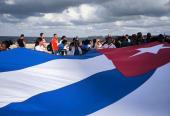Health Authorities Insist on Arbovirus Prevention
especiales

Authorities from Cuba's Ministry of Public Health (Minsap) insisted today on preventive work within communities to confront arbovirus-related illnesses, stating it is the only method to mitigate their impacts.
During a press conference, Carilda Peña García, Vice Minister of Minsap, highlighted the need to continue control actions, noting that all provinces are experiencing endemic transmission of the epidemic, except for the special municipality of Isla de la Juventud, which is currently in a state of alarm.
Peña García specified that in the week just ended, there was a 2.5 percent increase in reported patients with febrile symptoms compared to the previous week. This is attributed to the active case-finding efforts conducted in the eastern provinces, which have detected suspected or confirmed cases of arboviruses.
The Vice Minister explained that the majority of individuals with fever are receiving care at home. However, according to ministry estimates, approximately 9% are in hospital centers due to certain risk factors that could complicate the disease's progression.
She stated that there is a high circulation of the chikungunya virus in different regions of the country, a situation characterized in many cases by sick individuals not seeking care at health centers, and thus going unreported.
She detailed that there are 13 provinces with a high concentration of dengue cases, with serotype 4 being predominant. Villa Clara, La Habana, Sancti Spíritus, Las Tunas, and Artemisa are the territories with the highest incidence rates of suspected cases, above the national average.
She further reported that during this past week, no suspected or confirmed cases of Oropouche virus were diagnosed in the country.
She emphasized that, overall, the provinces of Matanzas, Cienfuegos, La Habana, Pinar del Río, and Guantánamo are experiencing the most complex epidemiological situation.
She also insisted on the importance of promoting the campaign against the mosquito as the disease vector and noted that every municipality has a department of hygiene and vector control responsible for managing the entire response process at that level.
Pediatric Population as a Key Risk Group
Yamirka Montesinos Felipe, Head of the National Group of Pediatric Intensive Care and Emergency, explained that regarding arboviruses, the fundamental risk group is children under one year of age, primarily those under three months, as they can develop complications more frequently. Children and adolescents with underlying conditions that may hinder their defense against the disease are also under close surveillance.
Montesinos Felipe underlined that among the clinical manifestations in the pediatric age group are sudden fever lasting 48 to 72 hours, skin lesions, joint pain, among other symptoms. She stressed that upon observing these signs, it is necessary to seek immediate medical attention to avoid potential complications.
Special Care for Pregnant Women
Dayana Couto Núñez, President of the Cuban Society of Gynecology and Obstetrics, highlighted that no maternal deaths due to the disease have been reported in the country, as this population receives special attention within the healthcare system, given the high risks involved.
She added that in a year dedicated to maternal health, the country is implementing a strategy to care for all pregnant women with any viral symptoms and simultaneously emphasized that early medical assistance is fundamental to reducing complications in this vulnerable group.
She also informed that hospital admission for pregnant women who are suspected or confirmed to have the viral process is a established control mechanism.
The Minsap representatives all agreed that the best preventive action is to eliminate the transmitting mosquito through "autofocal" activities in every home and neighborhood.














Add new comment